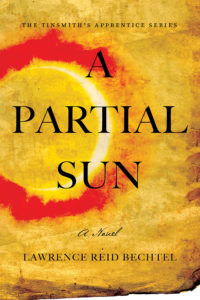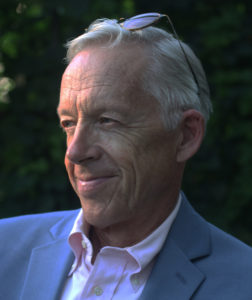New Release — Historical Fiction
 In 1852, after much searching through the Black districts of Petersburg, Virginia, the amateur historian Charles Campbell finally located Isaac Granger, a formerly enslaved man who worked for the late Thomas Jefferson.
In 1852, after much searching through the Black districts of Petersburg, Virginia, the amateur historian Charles Campbell finally located Isaac Granger, a formerly enslaved man who worked for the late Thomas Jefferson.
Though disinterested at first in sharing his memories, Isaac was at last persuaded to tell the full story of his time in Philadelphia as a young man in the early 1790s. It was supposed to have been a simple story: he would apprentice with a Quaker tinsmith and then return to Monticello to produce tinware for sale in such abundance that Jefferson might pay down his plantation’s crippling debts. But Isaac was impressionable and more thoughtful than Jefferson knew. Philadelphia was a big city, home to a thriving African-American community, and Isaac met all manner of characters: Billey Gardner, a formerly enslaved man who worked for James Madison; the dangerous and charismatic Dr. Cornelius Sharp; the Reverent Rich Allen; the hateful Daniel Shady, who could not abide that Isaac should learn tinsmithing at his side as an equal; the tinsmith’s daughter, Rachel, who taught Isaac to read. Isaac got himself into difficulties, contemplated his place in the world, and was challenged to do more than just serve.
Conflict was inevitable.
ISBN 978-1-945448-39-3 (Paperback)
Historical Fiction
6 x 9, 398 pages
Publication date: October 1, 2019
~~~~~
The summers of his high school years, he worked as an “engineer” at Honey Rock Camp, the Northwoods Campus of Wheaton College, in Wisconsin, where he was free to get sweaty and dirty doing sometimes dangerous work in the woods almost like he was a character out of one of Jack London’s novels. He graduated from Wheaton College with a B.A. in 1971, but because he felt somehow that it was his destiny to be a teacher like his father, he of course did not become a teacher, but did lots of other and very different things over the next ten years or so, such as backpacking in British Columbia, picking apples in Okenagon, Washington, and working in a boat shop on the Oregon coast.
Eventually, in about 1980, he settled with his first wife in Southwest Virginia. They had a son, Teague, and Larry went to work with her father and brother building houses. On the side, he reviewed books for The Roanoke Times, and wrote a column on stockcar racing called “Inside Racing” for The News Messenger. From this last experience he wrote his first (and as yet unpublished) novel, “The Favorite.” In 1983, he entered graduate school at Virginia Tech, writing his thesis on D.H. Lawrence, and reading a paper from that thesis at a Lawrence conference in Montpelier, France. In 1985, following completion of his graduate degree, he was hired by the English Department as an Instructor–becoming a teacher like his father after all and happy about it, too.
On the other hand, his marriage gradually broke down, the worse of it being the break he felt in his relationship with Teague and for therapy through the divorce he plunged himself into clay sculpting and wood carving. Through a mutual friend he met Ann Shawhan, who lifted his spirits with gifts of banana bread and cassette tapes of her favorite music and in 1990 they married, and his life transformed: they bought a little house, he became her daughter Rose’s stepdad, then later the happy father of their second daughter Haley, and they did their best to keep their cocker spaniel, Milo, from jumping the fence and seeking his own kind of experiences.
In 1991, after months of volunteering his time at the enterprise, he proposed to the university that he be hired as the university’s first Recycling Coordinator, which entailed a long jump from teaching English to working in the Grounds Department, but was a mission for him and he loved the inventiveness required of him. He had by that time also taken up figurative sculpture and secured over time significant public commissions; additionally, he had a wonderful time being the designated storyteller for children at the Blacksburg New School, and from that experience eventually recorded three CD’s worth of original stories.
He retired from Virginia Tech in 2009, celebrating the occasion with a hike up to Dragon’s Tooth and coming back down exuberant about the arts. Gradually, and with a purpose deepened from his friendship with Nannie Hairston, initiated from the Charles Schaeffer sculpture project for Schaeffer Church in Christiansburg, he at last turned his attention to the writing of what has become “A Partial Sun.” He is working on the sequel, “That Dazzling Sun.”





 Larry grew up in Wheaton, Illinois, home of Wheaton College, an institution dedicated to “Christ and His Kingdom.” His father taught literature there and wrote a history of the college, A Heritage Remembered. His mother was an elementary school librarian, who besides her love of good books for children, encouraged creativity in her four children, Larry being the eldest.
Larry grew up in Wheaton, Illinois, home of Wheaton College, an institution dedicated to “Christ and His Kingdom.” His father taught literature there and wrote a history of the college, A Heritage Remembered. His mother was an elementary school librarian, who besides her love of good books for children, encouraged creativity in her four children, Larry being the eldest.